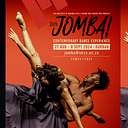JOMBA! Digital Fringe — A Sobering Perspective on Covid-19
By Thobile Maphanga
The JOMBA! Digital Fringe was a naturally unsweetened cocktail of dance films swirling around the swizzle stick of Covid-19. I have read somewhere that a good cocktail has tension which exists in the balance between its elements. In the 8 works served, they are a focus on place, access, realities, and boundaries.
With a consistent level of impeccable movement skill at their base, these works tease the intricacies of what pandemic might mean in an African context. The dance-makers’ commonalities converge around walls and water, how many you are faced with? And how much you have?
Sifiso Kweyama’s njengomfula ungenisa deals in the domestic. The simple understanding of the rules of this new way of existing and their usefulness are difficult to reconcile with customs of culture in dealing with loss. Almost as a public service announcement he uses sound and location to place us by the river.
Sabelo Cele’s (Rea)-Leaze Chains and Kaldi Makutike’s Therapy Session turn inward to confront the mental harm of inflictions on the body, deeply personal but equally political. Makutike takes us into his Therapy session. The effect of his easy-going voiceover as he moves gives us, his audience, the feeling of being in his body with him, sharing the same thoughts, uncertainties, and insecurities. A beautifully unguarded moment of collective healing.
Cele uses strong imagery, play on colour, and bodily markings to convey his message. The contrast of metal chains with those of toilet paper, both handled with the same level of burden reveals the fragility of man. The stitched mask that renders the drummer blind and mute whilst he sets a mesmerising tempo are, for me, elements that make (Rea)-Leaze Chains a worthy 2nd place selection for the “Pick-of-the-Fringe”. It’s a story of hope that depicts an alternative narrative of male healing.
Phumlani Life Mndebele’s Thirst opens with the Lord’s Prayer and a body stuck manoeuvring in the corner, begging the question “what happens when you come off that wall?” A display of performed masculinity, a show of strength, forced and pushing that seems quite useless in this moment. He seems to scream with his whole body, yet the tension does not diffuse. Trapped he returns to his corner.
Jena Woodroffe’s Balanced Isolation is a death-defying act on trapeze. As she lifts off the ground teetering alone in space, feeling unstable and insecure she contorts and dangles yet never faulters.
Pavishen Paideya’s AHAM — I AM which took third place in the “Pick-of-the-Fringe”, is a colourful display of beauty, healing and what lays hidden behind domestic walls. Set in a hollowed church it comments on gendered identity norms in the Indian community. The cinematography, full of light creates a level of serenity contrasted with moments of conflict.
Julie Veronirina Iarisoa and Robert Ssempijja’s films feel like a continuation of each other’s work, they both traverse the populated locations that ensure daily survival, but the dancers seem almost invisible to the inhabitants. Where Robert Ssempijja’s The MYTH OF ISOLATION highlights the insanity of Covid-19 regulations for most people living on this continent through posing questions that seem ignored. Julie Veronirina Iarisoa’s …And during that time I was dancing… depicts a being that expends energy in leaps, twists, turns, and undulations that begin to ground becoming economical with space, without losing expression of movement. The dancers almost become the virus in contrast to the people they dance amongst. In this reading it becomes interesting that Ssempijja is the only one wearing protective wear. His direct confrontation with the socio-political challenges of health regulations and his navigation of space place him squarely at number one for the “Pick-of-the-Fringe”.
Themes of loss, mental health, strength, partiality, and restriction blend together in this heavy drink representative of this moment. A sense of invisibility, as if a secret ingredient, lurks in the works. The unseen enemy ever present amongst people who carry on with the chores of daily living.
